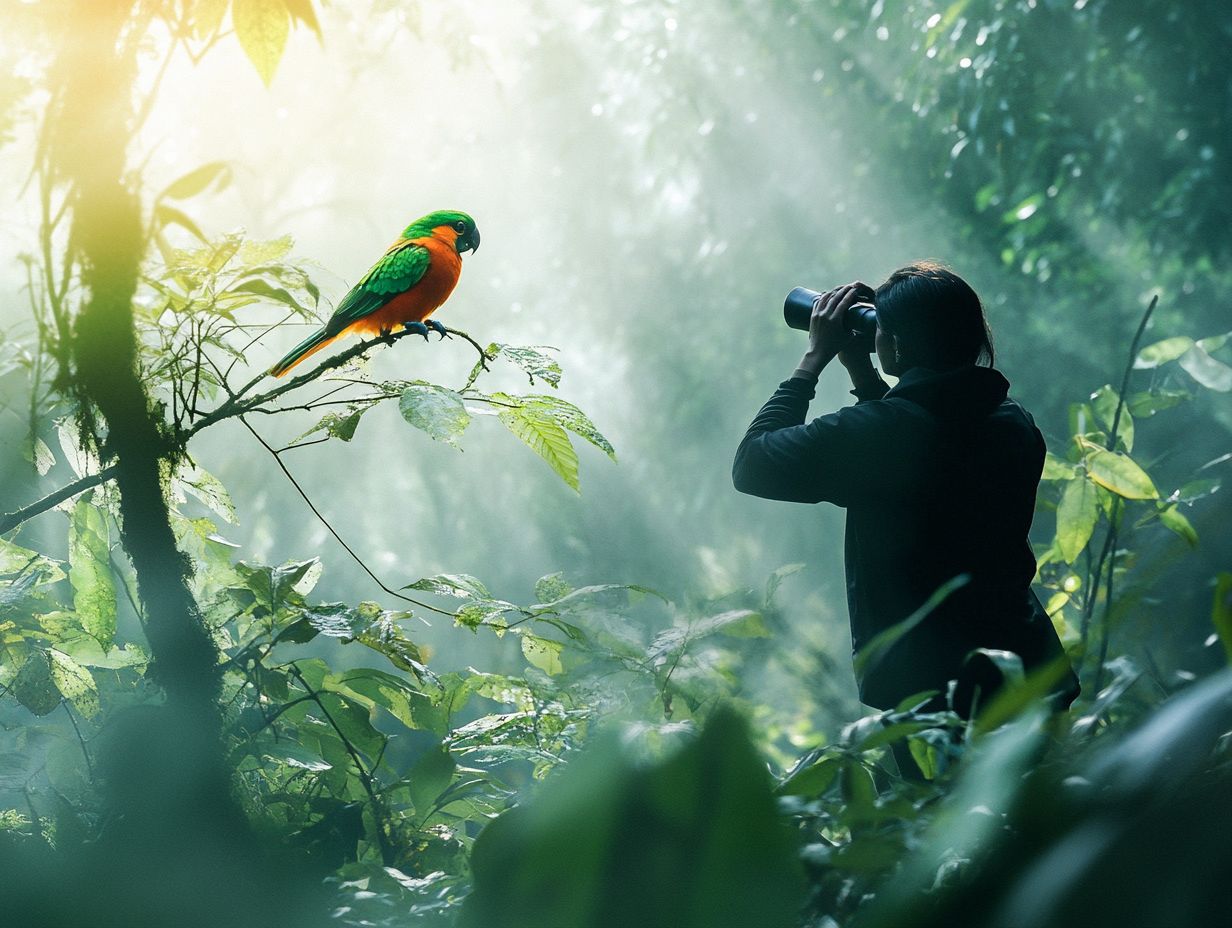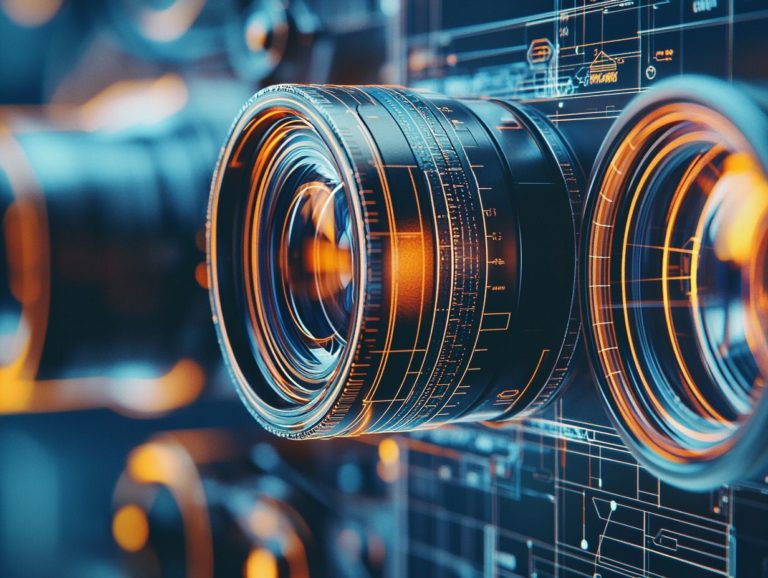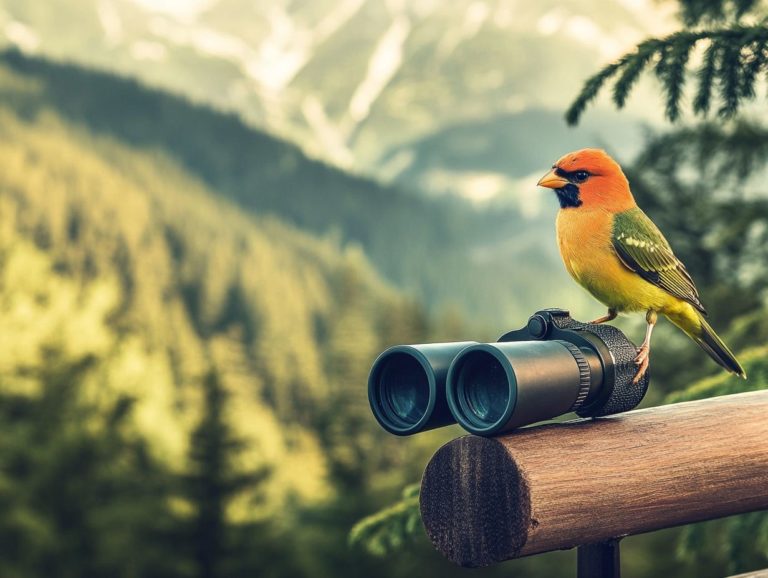What is the Best Magnification for Bird Watching?
Bird-watching is a captivating hobby that invites you to connect with nature and immerse yourself in its avian wonders.
At the heart of making your bird-watching more enjoyable lies the important part of magnification. Selecting the right level profoundly affects how you perceive and appreciate the diverse bird species around you.
This guide delves into the factors that influence your selection and weighs the pros and cons of various magnification levels. It offers valuable tips and recommendations tailored for every bird-watching scenario.
Whether you re a seasoned birder or just embarking on this journey, discovering the perfect magnification for thrilling bird-watching adventures can transform your outdoor experiences into truly unforgettable moments.
Contents
- Key Takeaways:
- The Importance of Magnification in Bird-Watching
- Factors to Consider in Choosing Magnification
- Recommended Magnification for Different Bird Watching Scenarios
- Pros and Cons of Different Magnification Levels
- Tips for Using Different Magnification Levels
- Frequently Asked Questions
- Best Magnification for Bird Watching
- Why is a Magnification of 8x or 10x Recommended for Bird Watching?
- Can I Use Higher Magnifications for Bird Watching?
- Do I Need a High-Quality Lens for Bird Watching?
- What Other Factors Should I Consider when Choosing a Magnification for Bird Watching?
- Is There a One-Size-Fits-All Magnification for Bird Watching?
Key Takeaways:

- The right magnification level enhances your bird-watching experience. See details and appreciate the beauty of birds more.
- Consider your distance, lighting, and preferences when choosing magnification.
- Experiment with low magnification for close-range viewing and high magnification for distant birds.
The Importance of Magnification in Bird-Watching
Magnification plays an important part in making your bird-watching experience more enjoyable, allowing you to appreciate the beautiful details of nature up close. Whether you re enjoying a peaceful afternoon in your backyard or embarking on an adventurous outing, the right level of magnification profoundly enhances your wildlife encounters.
Choosing high-quality optics such as those featuring ED glass (extra-low dispersion glass) which reduces color fringing, and phase correction coatings will boost clarity, contrast, and color fidelity. This thoughtful selection enhances every moment of your bird-watching journey, allowing you to immerse yourself in the beauty that surrounds you. Many backyard birders appreciate these features for a superior viewing experience.
How Magnification Enhances Bird-Watching Experience
Magnification plays a vital role in elevating your bird-watching experience, allowing you to appreciate the fine details of birds in their natural habitats.
With varying levels of magnification, you can enjoy a closer look at intricate feather patterns, unique beak shapes, and behaviors that often escape the naked eye. Lightweight binoculars designed for comfort and portability significantly ease the strain of extended observation, enabling you to track elusive species without the burden of heavy equipment.
Choosing the right magnification level helps tailor your experience to meet various bird-watching needs. For example, lower magnification works wonders for spotting birds across vast landscapes, while higher magnifications shine in scenarios that demand pinpoint accuracy, such as identifying distant or fast-moving species. Using lightweight binoculars allows for easy handling when tracking these birds.
Factors to Consider in Choosing Magnification
When choosing the right magnification for your bird-watching endeavors, several key factors warrant your attention to ensure a truly rewarding experience. Consider elements such as the distance from which you ll be observing, the lighting conditions you ll encounter, and your personal preferences. Each of these elements can be optimized with quality optics for an enhanced viewing experience.
Each of these aspects plays a crucial role in determining the ideal magnification level that will enhance your unique bird-watching adventures.
Distance of Observation
The distance of your observation plays an important part in bird watching. It directly impacts the magnification level you’ll need for the best viewing experience. Understanding this aspect will help you choose waterproof and fog-proof binoculars that are well-suited for various weather conditions.
When you watch birds from a distance, the intricate details of their feathers and behavior can become muddled, making it difficult to truly appreciate their natural beauty. For example, if you’re trying to spot a heron wading in a marsh, binoculars with higher magnification are essential to see its hunting techniques and vibrant colors. A casual observer might only catch a fleeting glimpse of its silhouette.
Conversely, when you’re observing small songbirds darting among the branches, you’ll want to focus closely. This proximity allows you to take in their vivid colors and unique markings in sharp detail.
Therefore, understanding how distance affects visibility is essential for elevating your bird watching experience. It enables you to enjoy more vivid and engaging encounters with the wonders of nature.
Lighting Conditions
Lighting conditions are crucial in determining how effectively you can magnify your view while bird watching.
When you step out into bright sunlight, the intensity can create a glare that hides the intricate details of feathers and subtle colors. On the flip side, during low-light situations like dawn or dusk, visibility can drop, making it quite a challenge to spot beautiful birds.
Incorporating optics with phase correction coatings can significantly enhance clarity, bringing forth more vibrant images even in less-than-ideal conditions. These sophisticated lenses optimize light transmission and minimize the effects of poor lighting, allowing you to enjoy a more vivid visual experience no matter where you are.
Personal Preference

Personal preference plays a critical role in selecting the right magnification for bird watching, as it can vary significantly among enthusiasts.
Whether you enjoy the peaceful experience of observing birds in your backyard or embark on serious field trips with field guides, your choice of magnification will reflect your unique style and approach. For casual bird watchers, a lower magnification might provide a broader field of view, allowing for easier tracking of movements in familiar surroundings.
If you find yourself exploring challenging terrains, you’ll want to grab higher magnifications to catch every detail of distant birds! Comfort is also paramount; if your binoculars feel heavy or unwieldy, even the most dedicated bird lover might hesitate before using them.
Prioritizing proper ergonomics and ease of use will significantly enhance your enjoyment of bird watching, leading to a more fulfilling experience in the enchanting realm of avian observation.
Recommended Magnification for Different Bird Watching Scenarios
Every birdwatching scenario demands a specific level of magnification to elevate your viewing experience, whether you’re observing up close, at mid-range, or from a distance.
Understanding the ideal magnification for each situation can greatly enhance both the enjoyment and effectiveness of your birding excursions.
Close-range Bird Watching
For close-range bird watching, it s advisable to opt for lower magnification levels. This ensures a broader field of view and enhances your focus on nearby subjects. It allows you to appreciate the intricate details of feather patterns and behaviors without straining your eyes or missing fleeting moments.
Binoculars like the Nikon Monarch 5 8×42 or the Vortex Diamondback 8×32 are particularly well-suited for these situations, offering clarity and a generous field of view that makes spotting elusive creatures easier.
With lower magnification, you can swiftly shift your gaze across your surroundings, making it perfect for observing the lively interactions common in backyard settings. This quick-reacting ability enriches your experience, resulting in a more immersive and enjoyable outing!
Mid-range Bird Watching
When you engage in mid-range bird watching, a moderate level of magnification strikes the perfect balance between detail and field of view. This makes it ideal for spotting birds in open fields or wooded areas. This equilibrium allows you to appreciate the intricate feather patterns and behaviors of the birds while still being able to track their movements effortlessly.
To elevate your experience, consider binoculars with a larger objective lens diameter. This added size brings in more light, ensuring you enjoy a clear image even in less-than-ideal lighting conditions. Features like image stabilization, which reduces blurriness from shaking hands, can significantly enhance your viewing experience.
Waterproof and fog-proof designs are essential, giving you the ability to pursue your passion for bird watching in various weather conditions without the constant worry about your equipment. Together, these features ensure that your birding adventures are not only enjoyable but also immensely rewarding.
Long-range Bird Watching
Long-range bird watching often demands high zoom levels to pinpoint distant species and truly appreciate their intricate features.
As you increase the magnification, achieving a clear and stable image can become quite the challenge. Even the slightest movement can lead to blurriness and shakiness, turning what should be a serene observation into a frustrating endeavor. Focusing on your feathered targets can feel like trying to catch smoke with your bare hands.
To tackle these challenges, consider investing in stabilizers or sturdy tripods. These essential tools provide a solid base for your binoculars or scopes, significantly enhancing your viewing experience. With them, you’ll enjoy detailed observations without compromising clarity. Investing in these accessories can truly make a difference when you’re on the hunt for those elusive species in the wild.
Pros and Cons of Different Magnification Levels
Grasping the pros and cons of various magnification levels is essential for making informed decisions in your bird-watching endeavors. Each level brings its own set of unique advantages and disadvantages.
By carefully evaluating these factors, you can select the ideal binoculars tailored to your specific needs and preferences.
Low Magnification

Low magnification levels in bird watching present distinct advantages for you, such as a wider field of view and improved stability. This makes them perfect for observing fast-moving or nearby birds.
This is especially beneficial during those lively moments when songbirds dart between branches or when migratory flocks take to the sky, enabling you to track their movements with ease. The lower magnification helps you spot these agile creatures in their natural habitats without the frustration of losing sight of them.
However, low magnification might not always be the best choice for distant observations. When you’re trying to identify species perched far away or want to appreciate the intricate details of plumage, higher magnification may be necessary to capture those nuances effectively.
Medium Magnification
Medium magnification strikes an impressive balance between detail and field of view in bird watching, making it an excellent choice for you as an enthusiast seeking versatility.
This optical range typically falls between 7x and 10x, enabling you to observe the subtle details of your feathered friends while still enjoying an expansive view of the surrounding environment. Such adaptability proves particularly useful in varied settings, from open fields to dense woodlands, where quick movements can easily be missed at higher magnifications.
Binoculars designed for this mid-range magnification often feature wider objective lenses to enhance light transmission and clarity. This is why models like 8×42 or 10×50 are especially popular among bird watchers. These combinations ensure you’ll enjoy every moment of your bird-watching adventure!
High Magnification
High magnification allows you to experience exceptional detail in bird watching. However, it can also introduce challenges, such as reduced stability and a narrower field of view.
These hurdles can be particularly frustrating for enthusiasts like yourself. The joy of observing feathered creatures can be diminished without the right tools. To truly appreciate the intricate markings and behaviors of birds from a distance, invest in quality optics to enjoy high magnification.
Using stabilization tools, such as tripods or image stabilization technology, becomes vital. Without these enhancements, your experience may become shaky, detracting from the pleasure of bird watching, which should ideally foster a seamless connection with nature.
Tips for Using Different Magnification Levels
To elevate your bird watching experience across different magnification levels, adopting effective tips for stabilization and optimal use of binoculars can significantly enhance your observations.
Adjusting for Shaky Hands
Adjusting for shaky hands while bird watching can truly elevate your overall viewing experience, especially when using higher magnifications.
For enhanced stability, consider employing a sturdy tripod or a high-quality stabilizer. These tools provide essential support for your binoculars, making it easier to focus on those elusive wildlife moments.
Proper hand positioning is equally important. Rest your elbows on a solid surface or hold the binoculars close to your body to significantly reduce unintended movement. These adjustments can greatly improve your experience, allowing for clearer views and minimizing frustration as you search for that rare bird perched in the distance.
Using Tripods or Stabilizers
Using tripods or stabilizers can significantly elevate your bird watching experience, providing steadier views even at high magnification levels where stability is essential.
This added steadiness minimizes shakiness, allowing you to relish clear and focused images of your feathered friends. If you’re using heavier binoculars, a robust tripod designed specifically for optics can offer balance and ease neck and arm fatigue during long observation sessions.
Lightweight options like monopods are perfect for quick setups in diverse environments, giving you the flexibility you need. For those venturing into more rugged areas, consider stabilizers that feature gimbals, which help reduce shaking and improve image clarity. By selecting the right equipment, you can immerse yourself more fully in your surroundings, capturing stunning details without distraction.
Frequently Asked Questions

Best Magnification for Bird Watching
The best magnification for bird watching depends on various factors such as the type of birds you want to observe, the distance between you and the bird, and the lighting conditions. Typically, a magnification of 8x or 10x is recommended.
Why is a Magnification of 8x or 10x Recommended for Bird Watching?
A magnification of 8x or 10x allows for a wider field of view, making it easier to locate birds and track their movements. It also provides enough detail to identify different species without causing eye strain.
Can I Use Higher Magnifications for Bird Watching?
While higher magnifications may seem appealing, they can actually make bird watching more difficult. Higher magnifications usually result in a narrower field of view, making it harder to find and track birds. They also require a more stable hand or tripod to avoid shaky images.
Do I Need a High-Quality Lens for Bird Watching?
A high-quality lens is definitely recommended for bird watching, as it can significantly enhance your viewing experience. High-quality lenses give sharper images for easier bird identification.
What Other Factors Should I Consider when Choosing a Magnification for Bird Watching?
Consider the type of lens (the front lens that collects light) and the diameter of the objective lens. The weight of the binoculars also plays a key role in your comfort while bird watching.
Is There a One-Size-Fits-All Magnification for Bird Watching?
There is no one-size-fits-all magnification for bird watching. Finding the right magnification requires testing various options to see what suits you best. Grab some binoculars and explore the great outdoors!






